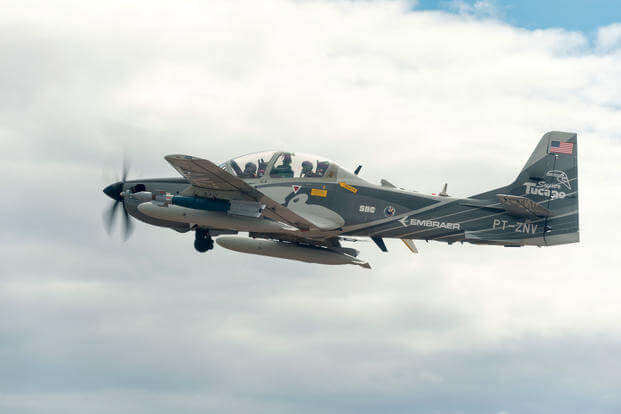The U.S. Air Force intends to buy a small fleet of turboprop aircraft as part of its light attack effort, putting some at Nellis Air Force Base, Nevada, and some with Air Force Special Operations Command at Hurlburt Field, Florida, the service's top general said Wednesday.
"What you'll see in this [2020] budget [request] is money we are going to use to procure a small number of aircraft," Chief of Staff Gen. David Goldfein told members of the Senate Appropriations defense subcommittee.
The Air Force will begin by purchasing up to three each of Textron Aviation's AT-6 Wolverine and Sierra Nevada/Embraer's A-29 Super Tucano.
"We're going to place a detachment with those at Nellis Air Force Base … where we do conventional training, and a detachment with those that do special operations at Hurlburt," Goldfein said.
Related content:
- Air Force Light Attack Effort Stalls After Experiments
- From Old Pilots to New Planes, Air Force Chief Talks 'New Ways of Doing Business'
- The Air Force's Light Attack Search Won't Yield a New A-10. Here's Why
He added that the Marine Corps is joining the light attack effort, and "we're going to invite allies and partners" into the program to expand and experiment in order to build an "interoperable network."
Goldfein said procurement funds for the full program will be laid out in the 2022 to 2024 budget cycles.
His announcement comes a day after the Air Force asked for an additional $35 million for light attack aircraft in its 2020 budget request, though it is not yet a Defense Department program of record.
Last month, the service said it will attempt another light attack experiment, possibly involving helicopters and drones and participation by allies who already have light attack aircraft. That plan is still on the table, Goldfein said.
Lawmakers have been eager to back a program proposal. In November 2017, key legislators agreed to provide the Air Force $400 million to continue experimenting with the light attack concept. The Senate Armed Services Committee, in its fiscal 2019 proposal, added an additional $300 million to procure a future light attack aircraft.
"Congress has appropriated approximately $200 million for Light Attack experimentation so far," Air Force spokeswoman Ann Stefanek told Military.com Wednesday. "There is approximately $60 million left in fiscal year 2018 research, development, test and evaluation funds and $100 million in fiscal year 2019 procurement funds. The Air Force plans to use these funds to purchase two to three of each aircraft."
Goldfein said the service kept three core principles in mind as it conducted past experiments: Keeping allies and partners who cannot afford fourth- or fifth-generation aircraft in the loop as they look to procure new planes; finding a mix of capabilities to make the planes interoperable; and realizing that these planes are not meant to be a replacement for anything in the service's inventory, but rather to provide additional capabilities.
In the past, Goldfein has described light attack as a "network approach" to share intelligence between partners.
Further experimentation will allow the Air Force to make "a smarter acquisition decision" with allies going forward, he said.
"We're two years into this" already, Goldfein said, pointing out that programs typically take five to 10 years just to get through research and development and testing and evaluation, among other milestones. "How much and what we buy depends on how the [next] experiment goes."
Speaking with reporters after the hearing, he said the service is exploring a conventional use for some of the aircraft at Nellis, as well as unconventional uses with special operations forces.
The Air Force has the opportunity "to invite international partners to these bases to take a look at what we're doing and flesh out this network and increase interoperability," Goldfein said. "And that's the next step of this."
The news comes after months of uncertainty surrounding the effort.
The Air Force was supposed to publish a final request for proposal in December for a light attack aircraft, but it never happened. A draft RFP was first issued last August.
The service first held a series of light attack experimental fly-offs and maneuvers at Holloman Air Force Base, New Mexico. In 2016, it announced plans to hold flight demonstrations with a handful of aircraft to test whether lighter, less expensive off-the-shelf planes might be suitable for lower-risk missions in places such as Afghanistan.
The second phase of the experiment was canceled last July following a fatal crash.
Even with the second phase cut short, Air Force officials have said the best fits for light attack are the Textron Aviation AT-6 Wolverine and Sierra Nevada/Embraer A-29 Super Tucano.
"The two companies that have been with us have been spectacular," Goldfein said Wednesday.
-- Oriana Pawlyk can be reached at oriana.pawlyk@military.com. Follow her on Twitter at @Oriana0214.










